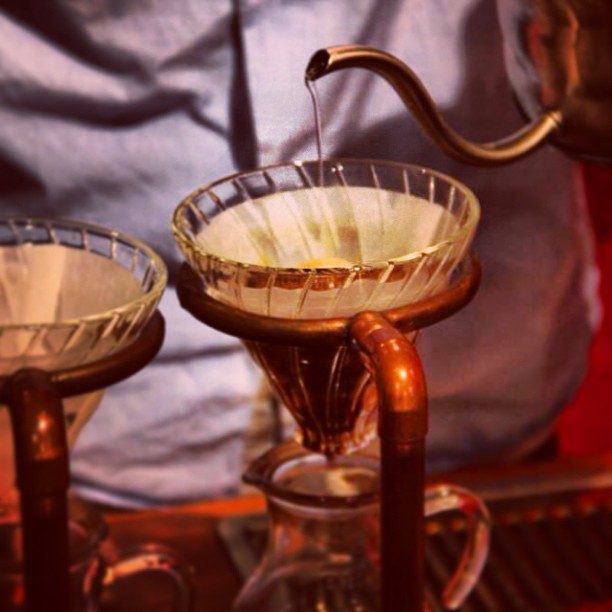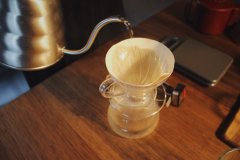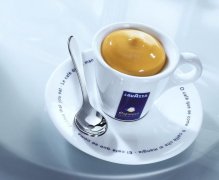Six best ways to make coffee by hand in the world

It has been nearly a month since the end of the 2015WBrC World Coffee Brewing Competition, and the wonderful scene of the game still leaves us a lot of room for discussion and learning. Here to share an article, a detailed interpretation of the WBrC top six contestants' brewing methods, I hope it will be helpful to you who like coffee.
The World Coffee Brewing Competition requires contestants to demonstrate excellent brewing skills and service at the same time. In front of the three judges, contestants from all over the world need to prepare and cook three drinks. In the preliminary round, the contestants will complete one designated cooking event and one free cooking event. In the designated brewing event, the contestant is required to prepare the drink with the coffee beans designated and provided by the competition. In the free brewing event, the contestants can choose their own coffee beans and cooking methods, and must show the whole process in front of the three judges.
After a fierce preliminary round, six of the 28 contestants were selected to enter the WBrC finals in the Swedish city of Gothenburg on Thursday, June 18, 2015. here are the details of their cooking methods from the sixth to the first contestants.
No. 6: the cooking method of Russian player Ruslan Shulga
The raw coffee beans used by contestant RuslanShulga from Russia come from the summer of roses grown in the sun at an altitude of more than 1700 meters from the Jade Manor. "Sun beans are quite sensitive to temperature during baking," Shulga said. In fact, Shulga tried to bake with different bean roasters more than 20 times before the competition before finally deciding on the baking method for the competition.
Shulga uses 15g of powder and 250g of water, hand-flushed with a V60 filter cup, and the coffee is rich in acid. Shulga coffee smells of citrus, caramel, and vanilla; it tastes of peach iced tea, citrus, caramel and moderately sweet citrus acid. As the coffee temperature drops, the acidity becomes more obvious.
Fifth: the cooking method of Dutch contestant Kerkhoff
Rob Kerhoff's opening remarks were wonderful: "Welcome to the mini version of the coffee table. Every aspect of coffee is full of innovation. Then innovation is bound to be reflected in his cooking process. Kerhoff uses coffee beans from El Diamante, Costa Rica, using anaerobic fermentation (anaerobic fermentation). Whether it's Kaduai or Kaddura, coffee beans smell like cinnamon after 20 hours of fermentation.
Kerkhoff invented his own method of cooking. Kerhoff said, "I wonder what kind of coffee I like." I like the mellow thickness of the coffee I drink in the cup and the brightness of the coffee made by Chemex. He combines the two methods, putting the Chemex filter paper in the filter net of the French kettle. Kerhoff uses 18g of powder and 300g of water, 120bp, 7.1 and 93 degrees. The extraction rate was optimized by continuous stirring during the extraction time of 5 minutes and 30 seconds. In the end, the coffee produced by Kerhoff has a slight malic acid, fresh cinnamon flavor and a moderate light taste. Kerhoff finished the race in 9: 40.
No. 4: the cooking method of American player Sarah Anderson
For this cooking competition, Anderson of the United States, who ranked fourth, used the the species eugenioides from Colombia variety from Colombia, which Anderson himself called "the breeder of Arabica bean seed." Because of its strong sweetness and delicate acidity, "this variety of coffee tastes quite different," Anderson said. The output of this kind of coffee beans was about 200 pounds last year, but there will be more and more in the future. Growing in a greenhouse, the coffee beans "are somewhat delicate and need people to adjust their surroundings to suit their growth," Anderson said, adding that the beans would then be put into a stainless steel fermentation container. Anderson and her Intelligentsia team in Los Angeles conducted more than 80 baking tests, and even more from Copenhagen's Coffee Collective, before they finally chose the most suitable baking method.
The Anderson uses a bird's nest filter cup (AltoAir brewing device, pictured above), which boils with 19g powder and 300g water in 8 minutes and 30 seconds (throughout the race). Anderson chose to steam in a glass for 1 minute and 30 seconds before pouring it into a bird's nest filter cup filled with filter paper. This cooking method can brighten the eyes of the judges. "one of my favorite experiences is to bring something new to my customers," Anderson told the judges. But you are professional in this field, and you are tasting the best coffee, how can I give you an unprecedented experience?
Anderson coffee smells of brown butter, black tea, and well-balanced and bright cream; it tastes sweet of sugarcane, mugi-cha 's charcoal, soft muskmelon and sour ripe peaches.
Third place: Swiss contestant Benjamin Prager's cooking method
"for me, Kenya is the best country in the world to grow coffee beans," was the opening remarks of Swiss contestant BenjaminPrager, who also described the sweet, clean, and strong flavor of Kenyan coffee. "in Kenya, the natural growth zone of coffee is the closest to perfection," Prager said. The coffee beans he chose grew on the southern side of Mount Kenya, 1800 meters above sea level, close to Nigeria. Because the land where coffee beans grow contains volcanic ash nutrients, Prager said: "the rich taste of coffee reflects the abundance of nutrients in the soil."
When it comes to Prager's cooking technique, his choice of filter cup is Hario V60, using 14 grams of sifted coffee powder, first using a 350 micron stainless steel filter and then using a 250 micron stainless steel filter. Then use a total of 236 grams of water, of which 30 grams are used for steaming. As opposed to segmented water injection, Prager's method is an one-off water injection as the water temperature drops at a constant temperature, because he thinks it will help increase the silky feel of the coffee.
Coffee is harvested in December and is stored in multi-layer plastic bags designed to store grains after being collected, sunburned or washed. Prager points out that the coffee smells floral, red currant and blackcurrant; the medium-light taste has blueberry tea, blue grape, and blackcurrant flavors. Prager finished the game in exactly 10 minutes.
Second place: Greek contestant Konstantinos Latridis's cooking method
The coffee beans used by Greek contestant Konstantinos Latridis are sun rosy summer, a micro-batch from Panama. Latridis chose HarioV60 as the filter cup and boiled it with 15g powder and 250g water. First, Latridis steams for 30 seconds with 96 degrees water, and then uses the rest of the water to finish the cooking.
Latridis explained to the judges that he chose the V60 filter cup just like using filter paper, because the use of V60 is easy to control the hand flushing, and the use of filter paper will make the coffee taste clean. Latridis also stressed that coffee has a slight berry, chocolate, nuclear fruit flavor; it smells of magnolia, black honey, and white tea. With a floral and juicy taste, this coffee is described by Latridis as "tastes like washed sun beans". The length of the Latridis game is 9 minutes 32 seconds.
First place: the cooking method of Norway's Odd-Steinar Tollefsen.
Norway's Tollefsen used raw coffee beans from Ethiopia's 90 + company to bask in honey kisses and described their roasted beans as "further improvements to honey kisses". This coffee bean is dried in the shade. While showing that only seven packs of raw beans have been roasted, Tollefsen said, "you don't know how delicious this coffee tastes until you dance in your mouth, because it speaks for itself." It is quite irresponsible if you make a lot of comments before drinking it.
During the competition, Tollefsen used 20 grams of powder and 300 grams of 92-degree water, together with HarioV60's filter cup for hand flushing. The steaming time is 45 seconds, and the total extraction time is 3 minutes and 30 seconds. Tollefsen used natural mineral water from the west coast of Norway, which is low in minerals and is softer and smoother.
In order to allow judges to have real-time cooking data, Tollefsen used Bluetooth to connect the Acaia electronic intelligent coffee scale to the iPhone. Tollefsen's hand-made coffee smells of tropical fruits, apricot, mango and passion fruit; the flavor is strawberry in addition to the fruit described above; sweet and sweet, accompanied by high-quality acidity with passion and mango flavours. Tollefsen finished the game in exactly 10 minutes.
Important Notice :
前街咖啡 FrontStreet Coffee has moved to new addredd:
FrontStreet Coffee Address: 315,Donghua East Road,GuangZhou
Tel:020 38364473
- Prev

What does Espresso mean? Espresso is a proper noun.
Today in China, more and more people go into cafes and drink freshly ground espresso, but most people drink cappuccino or latte with a lot of milk, but this start is not a bad thing, there is always a process, because there are many people who do not know what coffee is in their cappuccino or latte, maybe they only know that it is cof.
- Next

6 factors mentioned in SCAA manual about influencing coffee brewing
SCAA(Specialty Coffee Association of America) is the specialty coffee association of America. Founded in 1982, SCAE(Specialty Coffee Association of Europe) has become the largest specialty coffee promotion organization in the world, dedicated to training, certification and research. today and
Related
- Beginners will see the "Coffee pull flower" guide!
- What is the difference between ice blog purified milk and ordinary milk coffee?
- Why is the Philippines the largest producer of crops in Liberia?
- For coffee extraction, should the fine powder be retained?
- How does extracted espresso fill pressed powder? How much strength does it take to press the powder?
- How to make jasmine cold extract coffee? Is the jasmine + latte good?
- Will this little toy really make the coffee taste better? How does Lily Drip affect coffee extraction?
- Will the action of slapping the filter cup also affect coffee extraction?
- What's the difference between powder-to-water ratio and powder-to-liquid ratio?
- What is the Ethiopian local species? What does it have to do with Heirloom native species?

